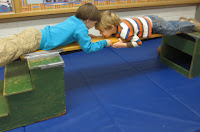Like any conference, participants came looking for activities. For our session, they were looking for ways to foster large motor/big body/boisterous play. There is nothing inherently wrong with that. However, without examining the values and the assumptions behind those activities, one cannot begin to understand the different ways and layers of learning that children engage in as they physically explore any given set up. To that end, we offered several value statements and questions for discussion to the participants.
Teaching
with the Body in Mind
NAEYC Annual
Conference. Washington D.C., 2018
Value Statements
Children use their
bodies as thinking tools to explore and make sense of the world.
There are body-based
modes of knowing and reasoning.
Action experience
alters reasoning in a range of contexts.
There is a role for
movement in cognition.
There are times when
children cannot do what you ask.
Biology and the need
to move trump social expectations.
Children ask
questions and make statements non-verbally with their bodies.
Children need to be
able to control their bodies.
There are times I
feel like I need to control children’s bodies.
___________________________________________________________________________________
Discussion Questions
What are our
assumptions surrounding the place for risk in care and education?
What are the
invisible assumptions that we do not talk about?
How do we create an
understanding of risk that confirms or questions our assumptions?
Who controls the risk
and how?
What are some of the
ethical considerations around risk and risk taking in school?
What conditions make
risk possible?
What conditions make
risk productive?
What conditions make
risk dangerous?
How does allowing for
risk-taking differ from anything-goes?
How does the language
of possibilities compare with the language of regulation?
What are your values
around risk taking?
Below is one of the main setups we used for illustration purposes. A board was set up as a bridge between two sets of steps. If we valued order and turn-taking in the name of safety, we would make sure that only one child crossed the board at a time and that everyone crossed in the same direction.
 If, on the other hand, we valued the children's ability to use their bodies as thinking tools to make physical and social sense of the world, we began to notice how well children assessed their own risks to stay safe.
If, on the other hand, we valued the children's ability to use their bodies as thinking tools to make physical and social sense of the world, we began to notice how well children assessed their own risks to stay safe.That certainly held true even when the play on the bridge became loud and rambunctious. In the clip below, the children hung upside down and screamed. Some of them even tumbled off the bridge onto the mat. Even though there was a very real possibility of a foot hitting a head, no child got bonked in the process.
Tumbling off the bridge from Thomas Bedard on Vimeo.
But wait, were the children really in control of their bodies? Was this acceptable risk taking or an example of anything goes?
We are all on a personal journey of becoming a teacher. It is not enough to simply copy activities. We must make them our own. And an important part of that process is to examine our values and assumptions around the activities we chose to copy or use. We cannot do it without the children so if you need inspiration, step back and watch the children as they make any part of the world their own.




No comments:
Post a Comment